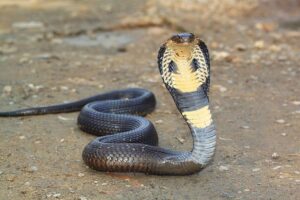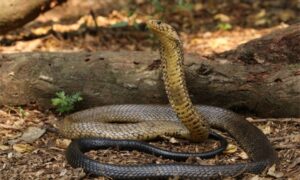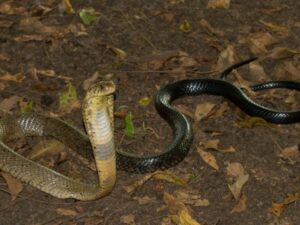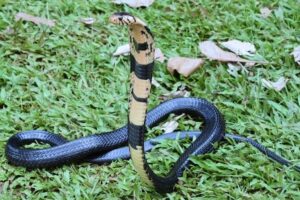Forest cobras are the largest species of cobra native to Africa. Also called the black cobra and the black and white-lipped cobra, they are venomous snakes belonging to the Elapidae family. They are the 4th most venomous true cobra and the largest true cobra species.
The forest cobras are agile, terrestrial, and diurnal species that are great climbers and swimmers. Their scientific name Naja melanoleuca combines two words, naja meaning “cobra” and melanoleuca meaning “black and white.” The Greek word melano means “black,” and the ancient Greek word leuca means “white.”
Scientific Classifications
- Suborder:Serpentes
- Family:Elapidae
- Genus:Naja
- Species:N. melanoleuca
Conservation Status
Sub-Genus and Morphs
The forest cobra is a group of five distinct species, which all belong to the same subgenus Boulengerina:
- Forest Cobra (Naja melanoleuca)
- Brown Forest Cobra (Naja subfulva)
- Sao Tome Island Forest Cobra (Naja peroescobari)
- Black Forest Cobra (Naja guineensis)
- West-African Banded Cobra (Naja savannula)
There are three morphs based on location:
- Glossy black with a cream or white throat, chin, and belly (Sierra Leone to western Kenya)
- Banded black and yellow, with a yellow throat, chin, and lips, a black tail, and the top of their head is brownish-yellow (West Africa)
- Brown or black body and a cream or yellow belly (East Africa)
Description
Size
The average length of adults is 4.6 – 7.2 feet, with a maximum length of 10 feet. Adult forest cobras weigh up to 4.4-7.9 lb. (2000-3600 g). Males and females are of the same length.
Color and Appearance
These snakes have large, broad, flattened heads distinct from the neck. They are slightly depressed and tapered with moderately thick bodies. When threatened, they expand their long cervical ribs to form a wedge-shaped hood.
Their entire body is covered with scales. The dorsal scales are glossy, smooth, and strongly oblique. The color of these snakes varies based on their geographic location.
Are They Dangerous to Humans?
Though forest cobras cause the least number of snakebites among the African cobras because of their forest-dwelling habits, their bite is dangerous because it releases a ton of venom. They are particularly aggressive when handled and can spit their venom. When agitated, they rear up to a considerable height, spread a long, narrow hood, and strike to a pretty long distance.
The amount of venom yielded in a taste varies with each bite, ranging from 571-1102 mg. Their venom is a postsynaptic neurotoxin which can cause severe neurotoxicity. It has an LD50 value of 0.324 mg/kg. The victims of their bite can survive if antivenom is given immediately. Failure to do so can lead to respiratory failure due to severe neurotoxicity, causing death. Immediate symptoms of their bite are ptosis, dizziness, hearing loss, shock, pain, ataxia, and fever.
Forest Cobra at a Glance
Distribution
These cobras live in the central and western regions of Africa. They are found in countries like Benin, Cameroon, the Central African Republic, Equatorial Guinea, the Democratic Republic of Congo, Nigeria, and northern Angola.
Habitat
Though they can adapt to different habitats, they are primarily found in savannahs, grasslands, lowland forests, and broken rock country. It is the only cobra that can adjust to high forest habitats. Known to prefer drier habitats, most researchers believe them to be semi-aquatic because of their excellent swimming ability.
They are common in tropical and subtropical regions of West and Central Africa. They also dwell in mangroves in western Africa. These snakes can adapt to a wide range of altitudes, from sea level to forested mountains at 9200 feet (2800 m) above sea level.
Lifespan
Forest cobras have a longer lifespan than other cobras. It is recorded that one of them lived for 28 years in captivity.
Predators
Mongooses are their most deadly predator. Their other predators include crocodiles, different species of snakes, such as the black mamba, and monitor lizards.
Wild pigs feed on their eggs, and birds of prey are known to prey upon juveniles.
Diet
They are a generalist feeder whose diet includes fish, amphibians, lizards, insects, mudskippers, other snakes, bird eggs, rodents, and other small mammals. Forest cobras that live in more aquatic habitats tend to feed primarily on fish.
Reproduction
Oviparous by nature, the females lay 11 to 26 white eggs in summer, which stick to each other. Each egg is roughly 1.2-2.4 inches (3-6 cm). Their incubation period ranges from 55 to 70 days at 27-30 degrees Celsius. Females are known to be aggressive and irritable during the breeding period. They give birth to independent hatchlings, which are 8.7-9.8 inches (22-25 cm) long. The hatchlings become sexually mature at 2-4 years of age.
These snakes are polygynandrous. Both males and females have multiple partners. Before mating, the pair dances for an hour by raising their heads a foot or more off the ground and swaying in a to-and-fro motion. Copulation occurs when the male presses his cloaca against that of the female.
Similar Species
Black Mamba
Black mambas are similar to forest cobras in many ways. Both of them have potent venom and live in Africa.
King Cobra
King cobras are larger than forest cobras.
Mozambique Spitting Cobra
Unlike forest cobras, they spit their venom. Mozambique spitting cobras have smaller holes in their fangs, while the forest cobras have bigger ones.
Source
animalfunfacts.net, a-z-animals.com, reptilesmagazine.com, static.wikia.nocookie.net









